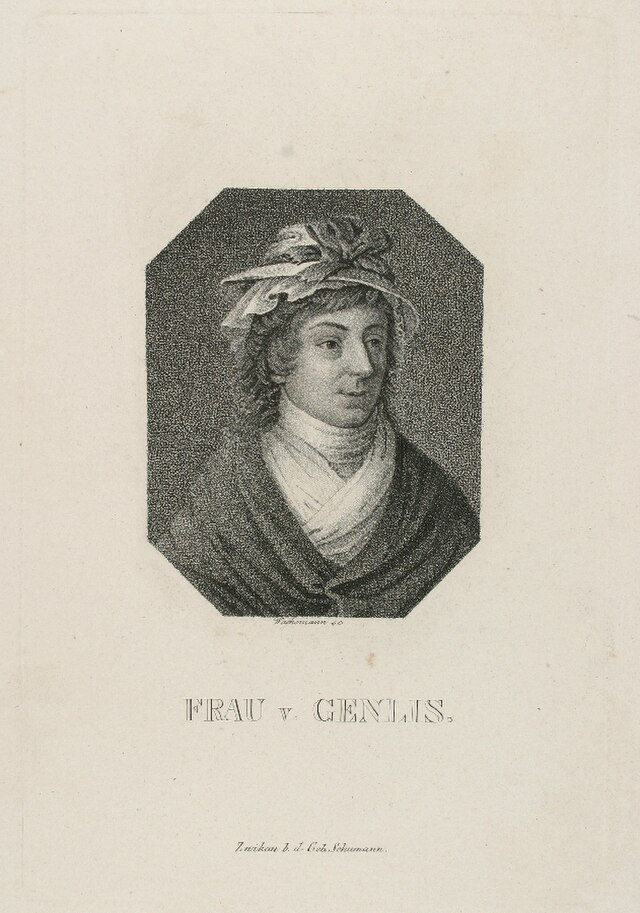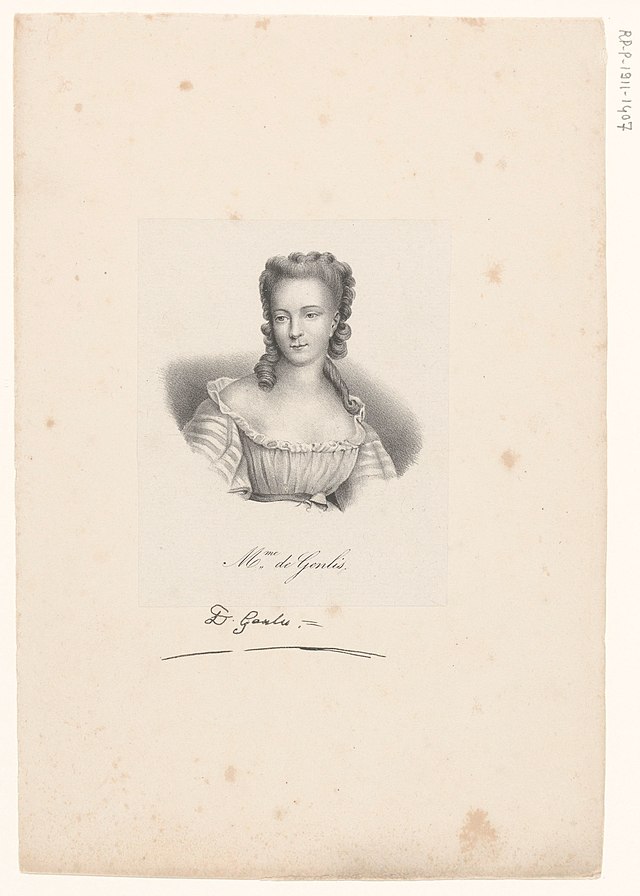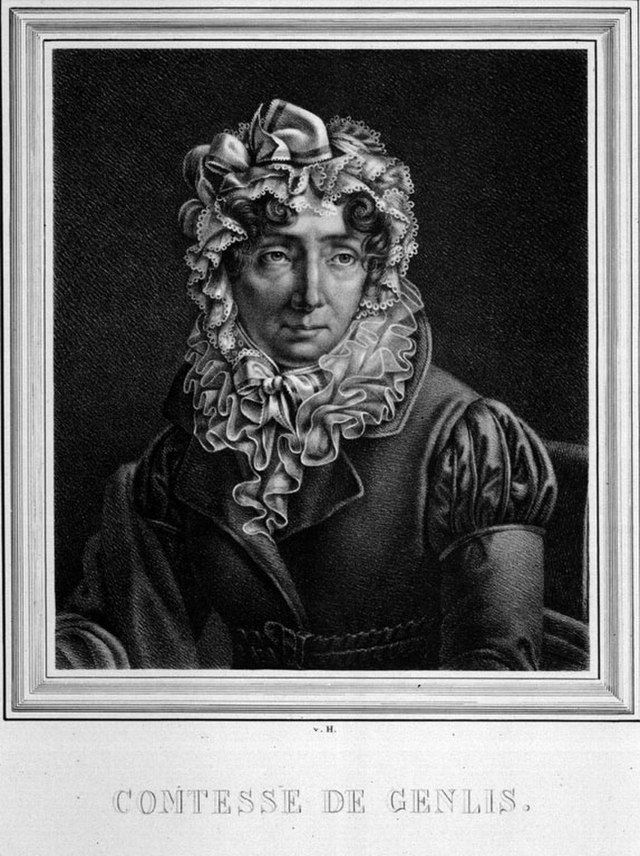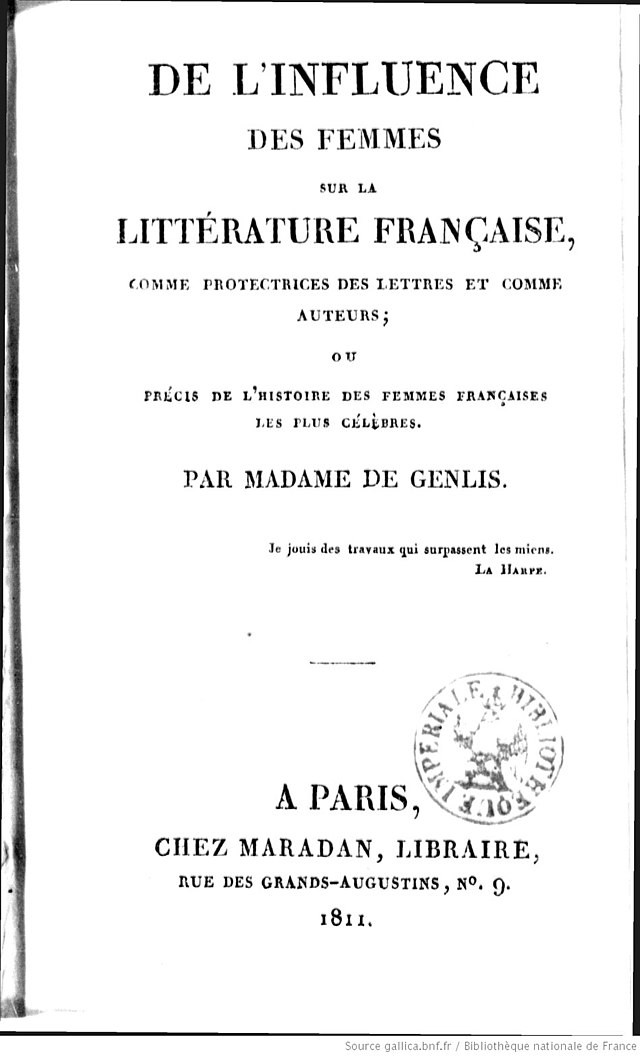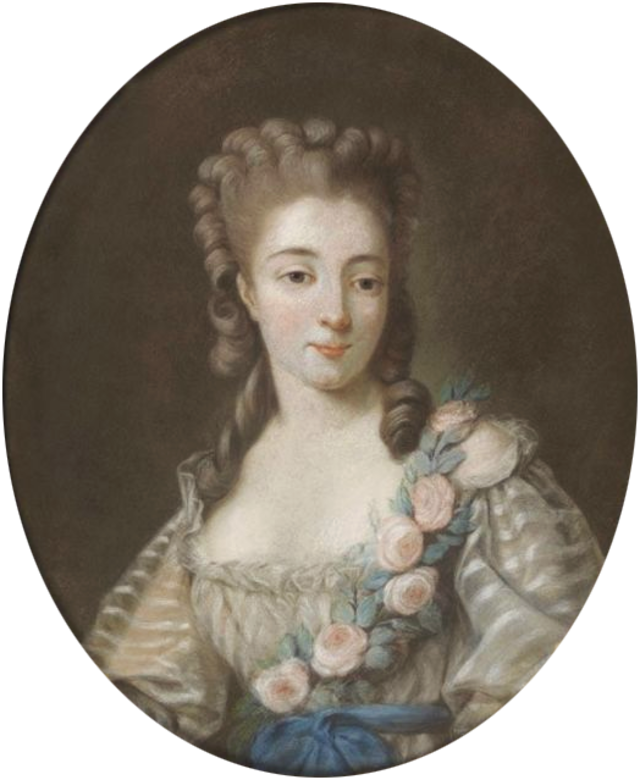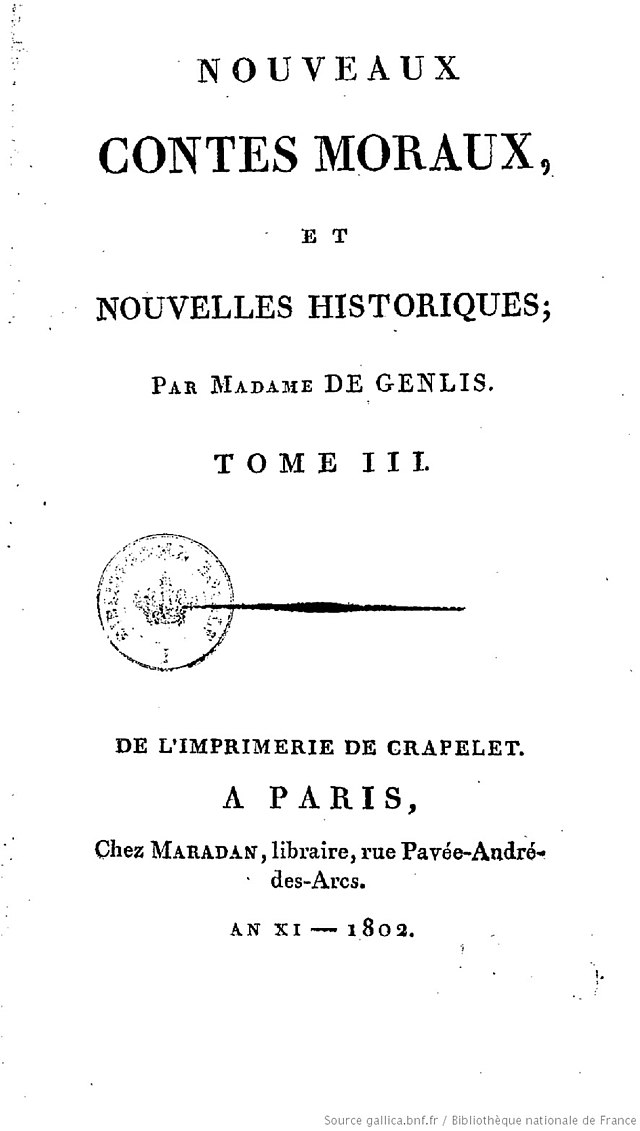Caroline Stéphanie Félicité, Madame de Genlis
*January 25, 1746, in Champcéry, France
†December 31, 1830, in Paris, France
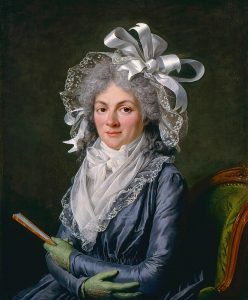
Stéphanie-Félicité Ducrest de Saint-Aubin, later known as Comtesse de Genlis, was born in 1746 in Champcéry, Burgundy. She grew up in an aristocratic but financially straitened family and her formal education was limited to the arts. In 1763, she secretly married Charles Alexis, comte Bruslart de Genlis, and was adopted into the family two years later. Known for her musical talent and acting skills, Genlis found favor in exclusive circles. However, her true influence developed when she joined the Palais-Royal in 1772 and was in the service of the Chartres family.
In 1779, she left her husband and began teaching the Chartres children, making her the female “governor” of the royal princes. As political tensions grew, she organized salons attended by influential reformers. Genlis was a writer and contributed to education with works such as “Théâtre à l’usage des jeunes personnes” (1779) and “Adèle et Théodore” (1782). Her literary success reached as far as England, where she received an honorary doctorate from Oxford University in 1785. After personal losses and the execution of her husband during the French Revolution, Genlis struggled with financial difficulties. She emigrated to England and returned to Paris a decade later, where she was supported by Napoleon and became a prolific writer.
Her oeuvre includes novels such as “Mademoiselle de Clermont” (1802) and historical writings such as “Histoire de Henri le Grand” (1815). Genlis left a lasting legacy as an educator, writer and influential figure in the political and literary circles of her time. In the last years of her life, Genlis lived in a Parisian boarding house in the Rue du faubourg du Roule and continued her intellectual activities, publishing manuals and novels until her death in 1830. (see Barclay, K., & Soyer, F. 2021, p. 178-181)
-
Primary Sources
Genlis, S. F. de. Der Frau Gräfin [Stéphanie Félicité] von Genlis Abendstunden auf dem Lande oder moralische Erzählungen für die Jugend. Leipzig: Siegfried Lebrecht Crusius.
Genlis, S. F. de. Le dernier voyage de Nelgis, ou mémoires d’un viellard ([Mikrofiche-Ausg.]). Paris: Roux [u.a.].
Genlis, S. F. de. Memoiren aus d. 18. Jh. u. aus d. franz. Revolution vom Jahre 1756 bis zur gegenwärt. Zeit: [In 2 Bdn]. Leipzig: Industrie-Comptoir.
Genlis, S. F. de. Oeuvres de Madame de Genlis ([Mikrofiche-Ausg.]). Paris: Lecointe et Durey.
Genlis, S. F. de. Placide: A Spanish tale ; in 2 vol ([Mikrofiche-Ausg.]). London: Simpkin & Marshall.
Genlis, S. F. de. Théatre à l’usage des jeunes personnes. Paris: Libraire es Associés.
Genlis, S. F. de. Théâtre de société ([Mikrofiche-Ausg.]). Paris: Lambert & Baudouin.
Genlis, S. F. de (1810). Der Frau von Genlis Mythologie in Arabesken: Durch 54 von ihr selbst gezeichn. Kupf. erl. ; Ein Handbuch f. d. Jugend, Künstler u. Liebhaber d. Alterhums. Leipzig: J. C. Hinrichs.
Genlis, S. F. de (1817). Les tableaux de M[onsieur] le comte de Forbin, ou La mort de pline l’ancien, et Inès de Castro: Nouv. histor ([Mikrofiche-Ausg.]). Paris: Maradan.
Genlis, S. F. de (1821). Six nouvelles morales et religieuses ([Mikrofiche-Ausg.]). Paris: Janet [u.a.].
Genlis, S. F. de (1823). Les veillées de la chaumière ([Mikrofiche-Ausg.]). Paris: Lecointe et Durey [u.a.].
Genlis, S. F. de (1824). Les athées conséquens, ou mémoires du commandeur de Linanges ([Mikrofiche-Ausg.]). Paris: Trouvé.
Genlis, S. F. de (1824). Les prisonniers: Cont. 6 nouv., et une notice histor. sur l’amélioration des prisons ; ouvr. fait pour les prisonniers et pour les personnes qui les visitent ([Mikrofiche-Ausg.]). Paris: Bertrand.
Genlis, S. F., Chinnery, M., & Yim, D. (2003). The unpublished correspondence of Mme de Genlis and Margaret Chinnery and related documents in the Chinnery family papers. Studies on Voltaire and the eighteenth century: 2003:02. Oxford: Voltaire Foundation.
Genlis, S. F., & Deguise, A. S. (1982). Mademoiselle de Clermont: Suivie de L’Histoire intéressante de Madame la Duchesse de C*** ([Réimpr. en facs.] / présentation d’Alix S. Deguise). Genève etc.: Slatkine.
-
Secondary Sources
Barclay, K., & Soyer, F. (2021). Caroline–stéphanie–Félicité, Madame de Genlis (1846–1830), Adelaide and Theodore; or Letters on Education, Containing all the Principles Relative to Three Different Plans of Education; to that of Princes, and to those of Young Persons of both Sexes: 3 vols (London: C. Bathurst, 1783), vol. 1, pp. 5–8, 10–18, 62–66. In Emotions in Europe, 1517-1914 (pp. 116-124). Routledge.
Couasnon, M. de (2010). La femme de lettres face à Rousseau: Mises en scène de soi dans la fiction (1791-1825). Villeneuve d’Ascq: Atelier national de reproduction des thèses.
Coüasnon, M. de (2013). Ecrire de soi: Mme de Genlis et Isabelle de Charrière au miroir de la fiction. Collection “Interférences”. Rennes: Presses universitaires de Rennes.
Ducrest, G. Paris en province et la province à Paris ([Mikrofiche-Ausg.]). Paris: Ladvocat.
Köthe, R. (1997). Vor der Revolution geflohen: Exil im literarischen Diskurs nach 1789. Wiesbaden: Deutscher Universitätsverlag. https://doi.org/10.1007/978-3-663-09119-6
Köthe, R. (1997). Vor der Revolution geflohen (Zugl.: Berlin, Freie Univ., Diss., 1996). Dt. Univ.-Verl, Wiesbaden.
Neschen-Siemsen, B. (1992). Madame de Genlis und die französische Aufklärung. Diss. phil. Bonn, 1991. Bonner romanistische Arbeiten: Vol. 44. Frankfurt a.M., Bern etc.: P. Lang.
Neschen-Siemsen, B. (1992). Madame de Genlis und die französische Aufklärung (Zugl.: Bonn, Univ., Diss., 1992). Lang, Frankfurt am Main, Berlin, Bern, New York, Paris, Wien.
Plagnol-Diéval, M.‑E. (1997). Madame de Genlis et le théâtre d’éducation au XVIIIe siècle. Studies on Voltaire and the eighteenth century: Vol. 350. Oxford: Voltaire Foundation.
Poortere, M. de (2003). Les idées philosophiques et littéraires de Mme de Stael et de Mme de Genlis. Diss. phil. State University of New York. Ann Arbor, Mich.: UMI University Microfilms International.
Poortere, M. de (2004). Les idées philosophiques et littéraires de Mme de Staël et de Mme de Genlis. Currents in comparative Romance languages and literatures: vol. 135. New York, Bern etc.: P. Lang.
Poortere, M. de (2004). Les idées philosophiques et littéraires de Mme de Stae͏̈l et de Mme de Genlis. Currents in comparative Romance languages and literatures: Vol. 135. New York, Washington, DC/Baltimore, Bern, Frankfurt am Main, Berlin, Brussels, Vienna, Oxford: Lang.
Poortere, M. de (2007). The philosophical and literary ideas of Mme de Staël and Mme de Genlis. Currents in comparative Romance languages and literatures: vol. 160. New York, Bern etc.: P. Lang.
Poortere, M. de (2007). The philosophical and literary ideas of Mme de Stae͏̈l and Mme de Genlis. Currents in comparative Romance languages and literatures: Vol. 160. New York, Washington, DC/Baltimore, Bern, Frankfurt am Main, Berlin, Brussels, Vienna, Oxford: Lang.
- Online Sources
- ECC
-
Media
-
Projects
-
Quotes
You cannot copy content of this page










